扩展功能
文章信息
- 桂志敬, 肖殿良, 宋浩然
- GUI Zhi-jing, XIAO Dian-liang, SONG Hao-ran
- 叠落式暗挖与盾构隧道施工的变形控制
- Deformation Control of Overlapped Bored Tunnel and Shield Tunnel Construction
- 公路交通科技, 2018, 35(8): 106-111, 122
- Journal of Highway and Transportation Research and Denelopment, 2018, 35(8): 106-111, 122
- 10.3969/j.issn.1002-0268.2018.08.015
-
文章历史
- 收稿日期: 2018-03-19
2. 交通运输部科学研究院 安全与应急研究中心, 北京 100029
2. Safety and Emergency Research Center, China Academy of Transportation Sciences, Beijing 100029, China
近年来,随着城市地下空间的利用程度不断提高,出现了大量近接施工的地下工程,包括同期施工的叠落隧道工程。国内外出现的同期施工的叠落隧道工程中,大多采用盾构施工,如日本京都地铁醒酮站到二条站的区间、东京到大阪山科站至三条站区间的隧道修建过矩形双层盾构重叠隧道;意大利—瑞士高速公路上采用垂直平行双车道双孔隧道。另外新加坡、俄罗斯也有重叠隧道的实例。我国上海明珠线二期浦南区间、人民公园站1号线和2号线交叉工程,深圳地铁1号线、3号线等也均采用过重叠隧道。与单洞隧道相比,叠落隧道的2条隧道产生的地层变形往往叠加,并且隧道间的相互影响使得地层变形更加复杂。在城市地下工程建设中,地层变形[1]是控制的重点,准确预测及现场量测隧道施工引起的地表变形对施工安全控制十分重要。
目前国内外学者采用理论分析[2-3]、数值分析[4-10]、现场实测[11-13]等手段对叠落隧道的地层变形规律及控制措施进行研究,也取得了一定的成果。但是这些研究多为单一施工工法的叠落隧道施工,对于不同施工工法隧道叠落的情况研究较少。本研究结合某地铁区间叠落式暗挖与盾构隧道工程,通过现场试验和数值分析研究叠落式暗挖与盾构隧道施工引起的地层变形规律及变形控制措施,以期为今后的类似工程提供依据。
1 工程概况某地铁区间,由右线始发井向东至左线盾构始发井之间为暗挖、盾构区间(左线上洞暗挖、右线下洞盾构),由左线盾构始发井向东至盾构接收井为盾构法区间。隧道管片外径为6 m,管片厚度30 cm,盾尾外径6.18 m,暗挖隧道断面高5.6 m,初支25 cm,二衬30 cm,如图 1所示。
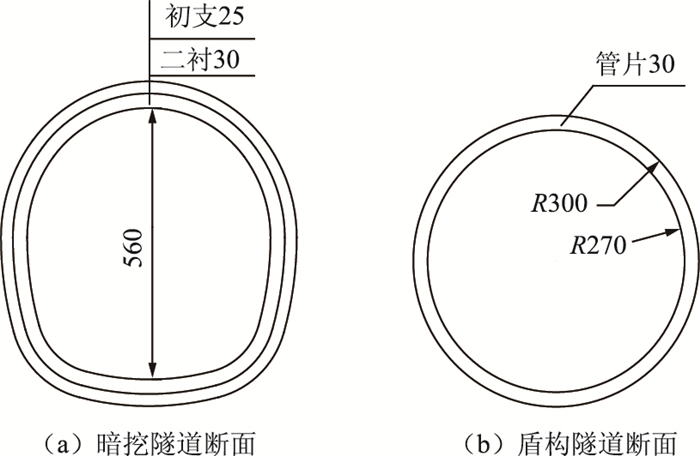
|
| 图 1 隧道横断面图(单位:cm) Fig. 1 Cross-section of tunnel(unit:cm) |
| |
隧道地质剖面见图 2,叠落段左线埋深13.8~15.1 m,穿越卵石层、粉质黏土层,局部粉细砂层;右线埋深21.9~23.6 m, 主要穿越粉细砂层、卵石层。
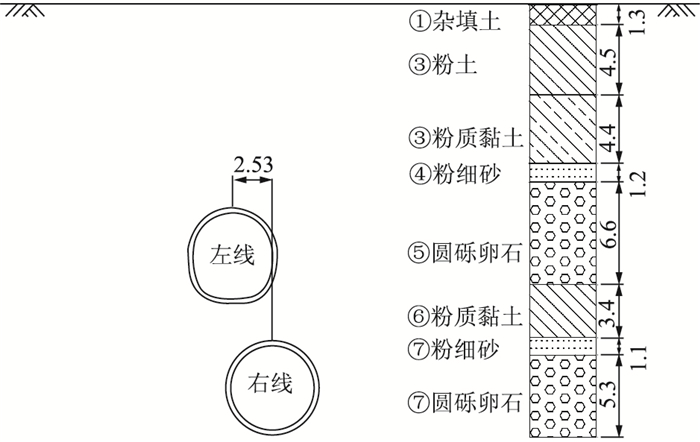
|
| 图 2 隧道剖面图(单位:m) Fig. 2 Profile of tunnel(unit:m) |
| |
2 地层变形的数值模拟
隧道施工前需要首先确定施工方案,由于左线和右线隧道所处地层条件不同,导致不同开挖顺序的地层响应有所不同,需对2条隧道开挖顺序进行优化研究,确定开挖顺序后,针对拟定的方案进行数值分析,计算开挖后产生的地表沉降值,若该施工方案无法满足沉降控制标准,需要采取相应的控制措施。根据相关文献和类似工程经验[14-15],本工程地表沉降控制标准取为30 mm。
2.1 数值模型及基本假定数值计算基本假定如下:地层材料采用摩尔-库仑准则计算;假定土层成层均质水平分布;初期衬砌、盾构管片采用壳单元模拟,地层采用实体单元模拟;不考虑隧道开挖对土体力学指标的影响以及地下水渗流影响。
采用FLAC 3d软件进行计算分析,整个模型计算范围为长100 m×高70 m×宽36 m(X×Z×Y),计算模型网格划分如图 3所示。隧道模型采用位移边界作为边界条件,除上表面为自由边界外,各外表面均约束法线方向的位移。右线盾构法开挖模拟时,在掌子面上施加0.2 MPa均布压力,每环宽度1.2 m。左线暗挖隧道采用台阶法施工,台阶长度3~5 m。结合区间暗挖盾构并行段工程情况,采用表 1所示的结构及土层力学参数。模拟施工过程按照工程实际开挖过程,设置2种工况:(1)先开挖下洞后开挖上洞;(2)先开挖上洞后开挖下洞。
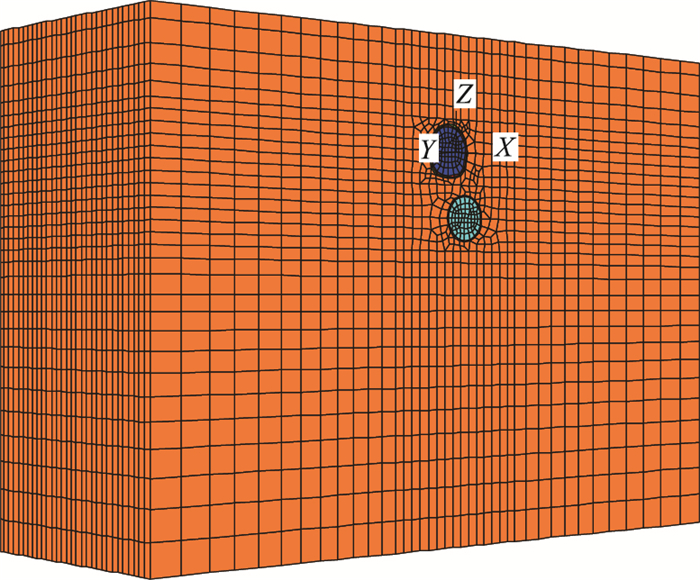
|
| 图 3 计算模型网格图 Fig. 3 Meshing of calculation model |
| |
| 土层 | 密度/ (g·cm-3) |
黏聚力/ kPa |
内摩擦角/(°) | 压缩模量/MPa | 泊松比 |
| ①杂填土 | 1.8 | 0 | 8 | 8 | 0.25 |
| ③粉土 | 1.99 | 13.83 | 26.67 | 10.53 | 0.22 |
| ③粉质黏土 | 1.96 | 13.5 | 29.5 | 5.52 | 0.31 |
| ④粉细砂 | 2 | 0 | 32 | 22 | 0.26 |
| ⑤圆砾卵石 | 2 | 0 | 45 | 45 | 0.21 |
| ⑥粉质黏土 | 2.04 | 35.33 | 21.5 | 14.7 | 0.28 |
| ⑦粉细砂 | 2.15 | 0 | 36 | 32 | 0.27 |
| ⑦圆砾卵石 | 2.3 | 0 | 48 | 60 | 0.2 |
| 初期支护 | 2.2 | — | — | 10 000 | 0.2 |
| 管片 | 2.5 | — | — | 29 300 | 0.2 |
2.2 计算结果分析
2种工况下得到的地表沉降曲线如图 4所示。2种施工顺序中,上线暗挖隧道施工阶段产生的地表沉降均明显大于盾构隧道施工。先开挖下行隧道时,地表沉降最大值为31.20 mm,先开挖上行隧道时,地表最大沉降值为37.4 mm,增加5.2 mm,最大沉降值均位于暗挖隧道拱顶上方。先开挖上行隧道产生的地表横向影响范围也要大于先开挖下行隧道。因此,叠落式盾构暗挖隧道施工采用“先下后上”施工顺序可以降低地表沉降及地表沉降槽的影响范围。
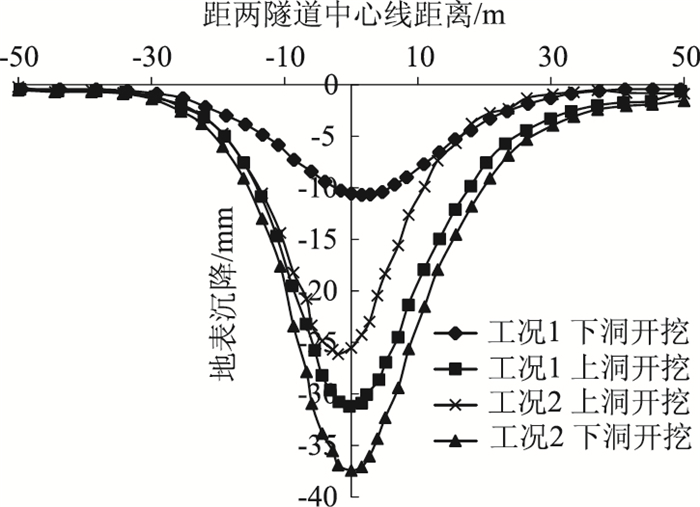
|
| 图 4 两种工况地表沉降曲线 Fig. 4 Surface settlement curves under 2 working conditions |
| |
由上述计算分析,2种工况施工得到的地表沉降值均大于30 mm的地表沉降控制标准,所以需要采取控制措施来减小地表沉降。由于沉降主要发生在暗挖隧道施工阶段,可在暗挖隧道施工时采取超前注浆的方式来加固地层,从而控制地表沉降。
3 变形控制措施的制定(1) 超前支护
隧道开挖前,对拱顶范围地层水平打设单排超前小导管注浆加固,以保证开挖期间土体稳定,加固完成后,及时做注浆效果检查,若注浆效果不好,考虑采用双排小导管注浆。小导管L=2.4 m,环向间距300 mm,超前支护见图 5。
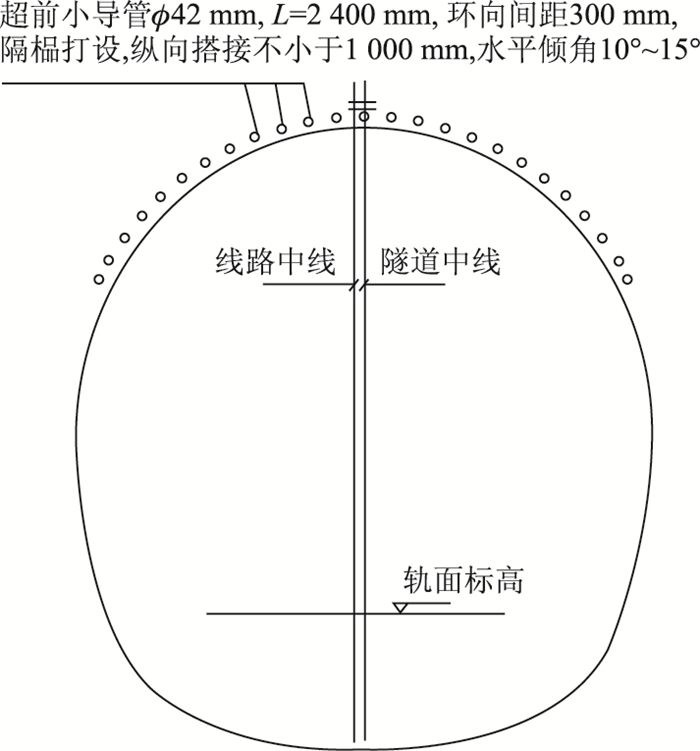
|
| 图 5 超前支护图 Fig. 5 Advanced support |
| |
(2) 开挖支护
区间隧道采用矿山法施工,施工前进行降水施工,将地下水位降至作业面以下1 m,保证暗挖作业的无水施工。
区间隧道标准断面采用台阶法施工,隧道开挖前严格按照设计要求打设超前小导管并注浆加固地层,保证开挖期间土体的稳定,注浆效果不好时,采用双排小导管注浆。
土体开挖后及时架立格栅钢架,挂网喷射混凝土封闭成环。为防止拱脚下沉,在格栅的每个拱脚处打设锁脚锚管且用方木块等垫实拱脚。为提高初期支护整体受力性能,前后2榀格栅之间纵向设置连接钢筋。
矿山法隧道初期支护施工时在初衬的拱顶和拱脚部位预埋ϕ42钢管作为初支背后回填注浆管,在初期支护达到强度后及时进行初支背后的回填注浆,使初期支护与地层密贴,注浆压力控制在0.3~0.5 MPa。
矿山法隧道开挖步序如图 6所示。
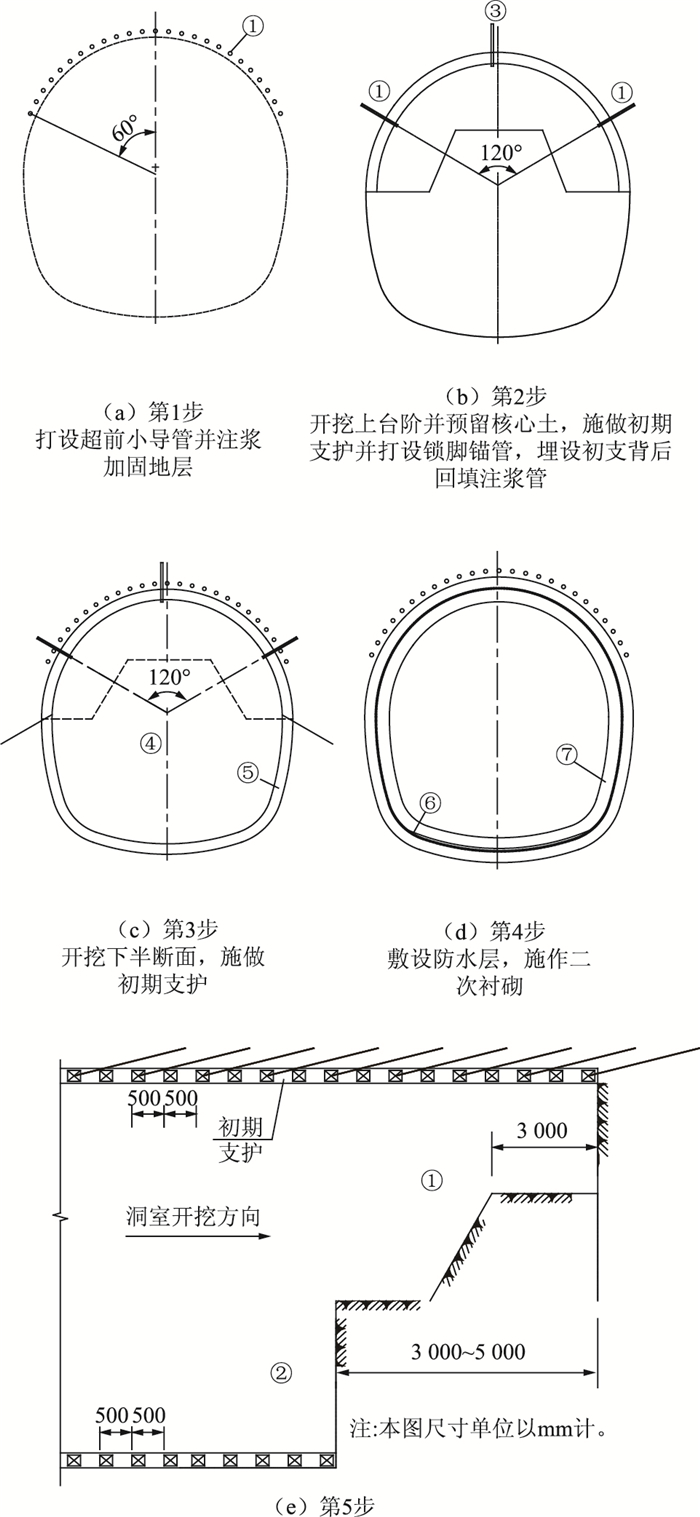
|
| 图 6 左线暗挖隧道开挖步序图 Fig. 6 Step sequence of bored tunnel construction at left side |
| |
(3) 地表沉降的预测及过程控制
采用上述地层加固措施,对叠落式盾构暗挖隧道施工引起的地层变形进行预测,采用的模型和计算参数与2.1节相同,注浆加固体采用弹性实体单元等效模拟[16-17],实际模拟中通过改变加固区域实体单元的材料属性来实现,加固体弹性模量取100 MPa,泊松比取0.22。得到采取加固措施后的地表沉降曲线,见图 7,最大地表沉降为19.3 mm,最大沉降值及在地表的影响范围均小于不注浆的情况,说明控制措施能够将地表变形控制在30 mm的标准以内。
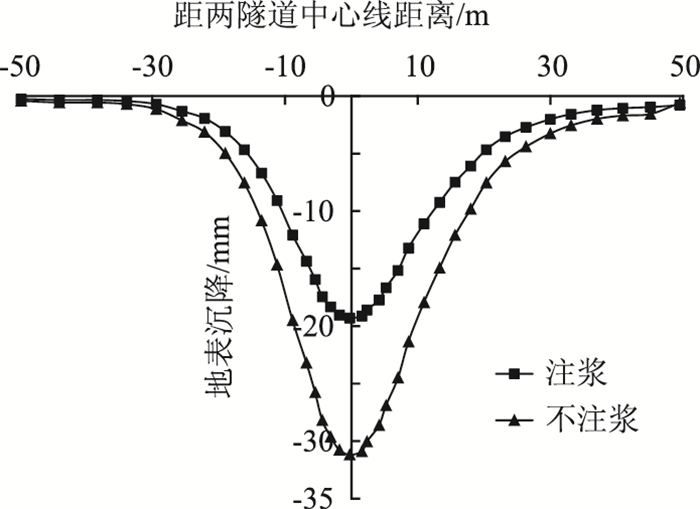
|
| 图 7 注浆与不注浆的地表沉降曲线 Fig. 7 Settlement curves of grouting and no-grouting |
| |
叠落式盾构暗挖隧道的地层变形在各施工阶段是不断累积的,采用变位分配[18]的方法,将各施工阶段作为地层变形的影响因子,分配地层变形控制目标至各施工阶段,对地层变形进行分阶段控制。盾构暗挖叠落隧道施工过程分为以下几个阶段:①盾构隧道施工;②暗挖隧道地层预加固;③暗挖上台阶施工;④暗挖下台阶施工;⑤施作二衬。根据数值模拟得到各步序沉降占总沉降的比重,将其分配到变形控制标准中,得到施工的过程控制标准如图 8所示。施工过程中按照过程控制曲线进行分阶段变形控制。
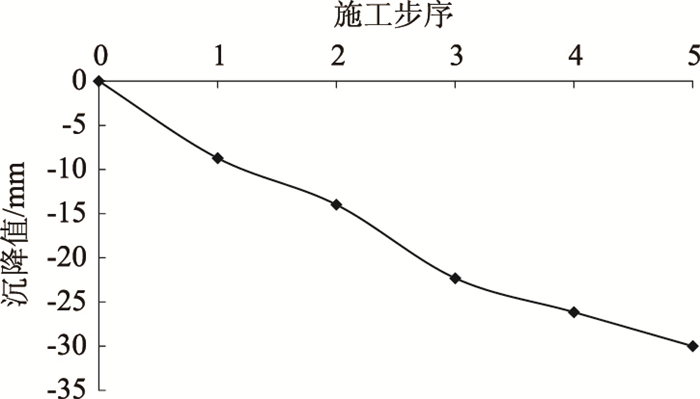
|
| 图 8 各阶段变形控制标准 Fig. 8 Control criteria of deformation at different stages |
| |
4 现场实测对比与分析
施工过程中对隧道开挖产生的地表沉降进行监测,图 9中的曲线分别表示施工过程中各阶段的沉降曲线,可见:各阶段的地表沉降曲线基本符合正态分布曲线,且随着施工的进行沉降值不断增大;右线盾构隧道施工产生最大沉降为6.5 mm,左线暗挖隧道施工产生沉降明显大于盾构隧道,最终总沉降最大值为18.6 mm,位于左线隧道拱顶上方。
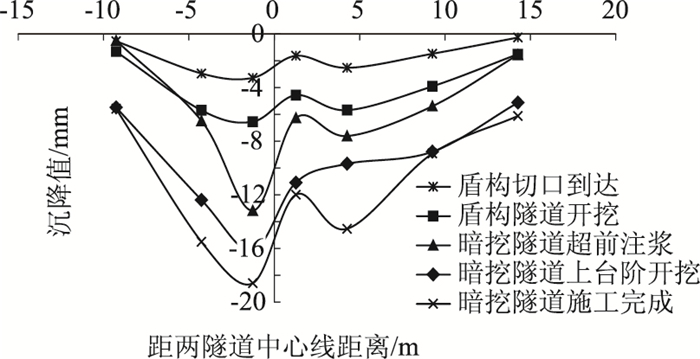
|
| 图 9 各施工阶段地表沉降曲线 Fig. 9 Surface settlement curves at different construction stages |
| |
图 10为数值计算与实测结果的对比情况,可以看出:右线隧道单独开挖引起的最大沉降值比模拟结果大1.5 mm,双线隧道地表累积最大沉降值比模拟结果小0.7 mm,但两者规律大致相同,数值模拟与监测结果基本吻合。
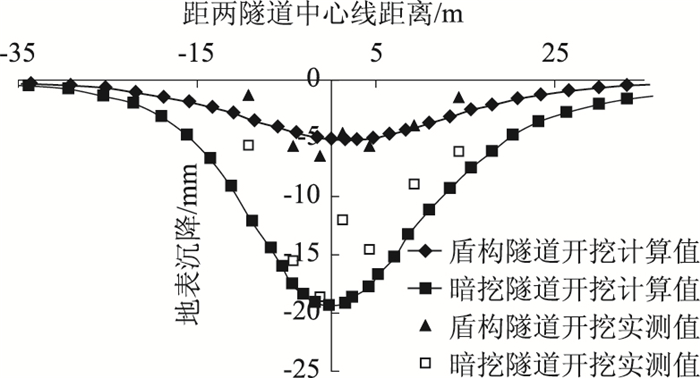
|
| 图 10 地表沉降曲线 Fig. 10 Surface settlement curves |
| |
图 11为制订的过程控制曲线与实测的对比情况,可以看到施工各阶段沉降值均没有超过控制标准,说明所采取的施工方案及控制措施能够降低叠落式盾构与暗挖隧道施工对环境的影响,达到保护周围环境的目的。
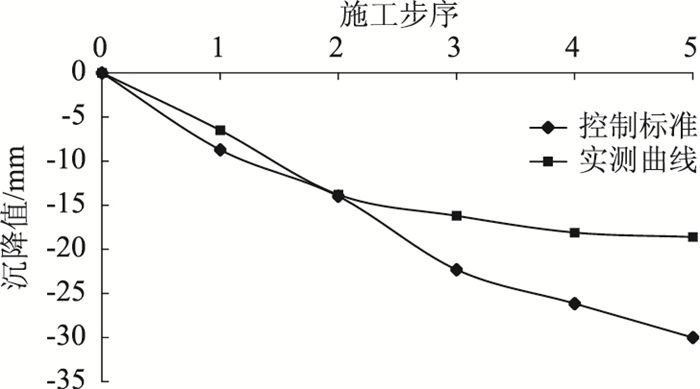
|
| 图 11 过程控制曲线 Fig. 11 Process control curves |
| |
5 结论
本研究根据某地铁区间叠落式暗挖与盾构隧道工程,通过现场实测与数值模拟对施工产生的地层变形及控制对策进行研究,主要得到以下结论:
(1) 暗挖隧道(上行)施工产生的地表沉降明显大于盾构隧道(下行)开挖,两洞施工结束后的地表沉降最大值位于暗挖隧道拱顶上方。
(2) 对不同开挖顺序产生的地表变形而言,“先上后下”施工产生的地表最大沉降值及沉降影响范围均大于“先下后上”施工,工程实际中可采用“先下后上”得施工顺序。
(3) 实测数据表明,将暗挖隧道作为变形控制重点,通过对暗挖隧道采取超前注浆,可使地表沉降满足控制标准,减小两隧道开挖的地表影响范围,说明在暗挖隧道中采用超前注浆可作为叠落式暗挖与盾构隧道修建过程中的重要安全控制措施。
| [1] |
张顶立. 城市地下工程建设安全风险及其控制[M]. 北京: 化学工业出版社, 2012, 108-109. ZHANG Ding-li. Safety Risks and Corresponding Control Measures of Urban Underground Engineering Construction[M]. Beijing: Chemical Industry Press, 2012, 108-109. |
| [2] |
OSMAN A S. Stability of Unlined Twin Tunnels in Undrained Clay[J]. Tunnelling & Underground Space Technology, 2010, 25(3): 290-296. |
| [3] |
刘大刚, 陶德敬, 王明年. 地铁双隧道施工引起地表沉降及变形的随机预测方法[J]. 岩土力学, 2008, 29(12): 3422-3426. LIU Da-gang, TAO De-jing, WANG Ming-nian. Stochastic Method for Predicting Ground Surface Settlement and Deformation Induced by Metro Double Tube Tunneling[J]. Rock and Soil Mechanics, 2008, 29(12): 3422-3426. |
| [4] |
黄俊, 张顶立. 地铁重叠隧道上覆地层变形的数值模拟[J]. 岩石力学与工程学报, 2005, 24(12): 2176-2182. HUANG Jun, ZHANG Ding-li. Numerical Simulation of Stratum Deformation above Overlapping Metro Tunnel[J]. Chinese Journal of Rock Mechanics and Engineering, 2005, 24(12): 2176-2182. |
| [5] |
刘维, 唐晓武, 甘鹏路, 等. 富水地层中重叠隧道施工引起土体变形研究[J]. 岩土工程学报, 2013, 35(6): 1055-1061. LIU Wei, TANG Xiao-wu, GAN Peng-lu, et al. Soil Deformation Induced by Overlapping Tunneling in Water-bearing Strata[J]. Chinese Journal of Geotechnical Engineering, 2013, 35(6): 1055-1061. |
| [6] |
孙钧, 刘洪洲. 交叠隧道盾构法施工土体变形的三维数值模拟[J]. 同济大学学报, 2002, 30(4): 379-385. SUN Jun, LIU Hong-zhou. 3-D Numerical Simulation of Ground Surface Settlement under Overlapped Shield Tunneling[J]. Journal of Tongji University, 2002, 30(4): 379-385. |
| [7] |
肖潇, 张孟喜, 吴惠明, 等. 多线叠交盾构施工引起土体变形数值模拟分析[J]. 地下空间与工程学报, 2011, 7(5): 884-889. XIAO Xiao, ZHANG Meng-xi, WU Hui-ming, et al. Numerical Simulation Analysis on Ground Settlements Caused by Multi-line Shield Tunnel[J]. Chinese Journal of Underground Space and Engineering, 2011, 7(5): 884-889. |
| [8] |
陶连金, 孙斌, 李晓霖. 超近距离双孔并行盾构施工的相互影响分析[J]. 岩石力学与工程学报, 2009, 28(9): 1856-1862. TAO Lian-jin, SUN Bin, LI Xiao-lin. Interaction Analysis of Double Holes Extremely Close Approaching Parallel Shield Tunnels Construction[J]. Chinese Journal of Rock Mechanics and Engineering, 2009, 28(9): 1856-1862. |
| [9] |
SOLIMAN E, DUDDECK H, AHRENS H. Two-and Three-dimensional Analysis of Closely Spaced Double-tube Tunnels[J]. Tunnelling and Underground Space Technology, 1993, 8(1): 13-18. |
| [10] |
YAMAGUCHI I, YAMAZAKI I, KIRITANI Y. Study of Ground-tunnel Interactions of Four Shield Tunnels Driven in Close Proximity, in Relation to Design and Construction of Parallel Shield Tunnels[J]. Tunnelling and Underground Space Technology, 1998, 13(3): 289-304. |
| [11] |
台启民, 张顶立, 房倩, 等. 暗挖重叠地铁隧道地表变形特性分析[J]. 岩石力学与工程学报, 2014, 33(12): 2472-2480. TAI Qi-min, ZHANG Ding-li, FANG Qian, et al. Analysis of Ground Surface Deformation Induced by Excavation of Crossing Metro Tunnels in Urban Underground[J]. Chinese Journal of Rock Mechanics and Engineering, 2014, 33(12): 2472-2480. |
| [12] |
张成平, 张顶立, 王梦恕, 等. 浅埋暗挖重叠隧道施工引起的地层变形分析[J]. 岩石力学与工程学报, 2008, 27(增1): 3244-3250. ZHANG Cheng-ping, ZHANG Ding-li, WANG Meng-shu, et al. Analysis of Stratum Deformation Induced by Overlapping Tunnels Construction in Shallow Depth[J]. Chinese Journal of Rock Mechanics and Engineering, 2008, 27(S1): 3244-3250. |
| [13] |
唐晓武, 甘鹏路, 刘维, 等. 渗流作用下重叠隧道施工引起地层变形[J]. 中南大学学报:自然科学版, 2016, 47(9): 3108-3116. TANG Xiao-wu, GAN Peng-lu, LIU Wei, et al. Ground Deformation Induced by Overlapped Tunneling under Seepage Condition[J]. Journal of Central South University:Science and Technology Edition, 2016, 47(9): 3108-3116. |
| [14] |
姚宣德, 王梦恕. 地铁浅埋暗挖法施工引起的地表沉降控制标准的统计分析[J]. 岩石力学与工程学报, 2006, 25(10): 2030-2035. YAO Xuan-de, WANG Meng-shu. Statistic Analysis of Guideposts for Ground Settlement Induced by Shallow Tunnel Construction[J]. Chinese Journal of Rock Mechanics and Engineering, 2006, 25(10): 2030-2035. |
| [15] |
齐震明, 李鹏飞. 地铁区间浅埋暗挖隧道地表沉降的控制标准[J]. 北京交通大学学报, 2010, 34(3): 117-121. QI Zhen-ming, LI Peng-fei. Control Standard of Ground Surface Settlements in Metro Section Shallow Tunnel[J]. Journal of Beijing Jiaotong University, 2010, 34(3): 117-121. |
| [16] |
杨坪, 唐益群, 彭振斌, 等. 砂卵(砾)石层中注浆模拟试验研究[J]. 岩土工程学报, 2006, 28(12): 2134-2138. YANG Ping, TANG Yi-qun, PENG Zhen-bin, et al. Study on Grouting Simulating Experiment in Sandy Gravels[J]. Chinese Journal of Geotechnical Engineering, 2006, 28(12): 2134-2138. |
| [17] |
孙锋, 张顶立, 陈铁林, 等. 土体劈裂注浆过程的细观模拟研究[J]. 岩土工程学报, 2010, 32(3): 474-480. SUN Feng, ZHANG Ding-li, CHEN Tie-lin, et al. Meso-mechanical Simulation of Fracture Grouting in Soil[J]. Chinese Journal of Geotechnical Engineering, 2010, 32(3): 474-480. |
| [18] |
扈世民, 王梦恕, 张丽, 等. 基于变位分配法地铁车站变形规律研究[J]. 岩石力学与工程学报, 2013, 32(2): 258-265. HU Shi-min, WANG Meng-shu, ZHANG Li, et al. Study of Metro Station Deformation Regularity Based on Deflection Distribution Control Method[J]. Chinese Journal of Rock Mechanics and Engineering, 2013, 32(2): 258-265. |
 2018, Vol. 35
2018, Vol. 35
